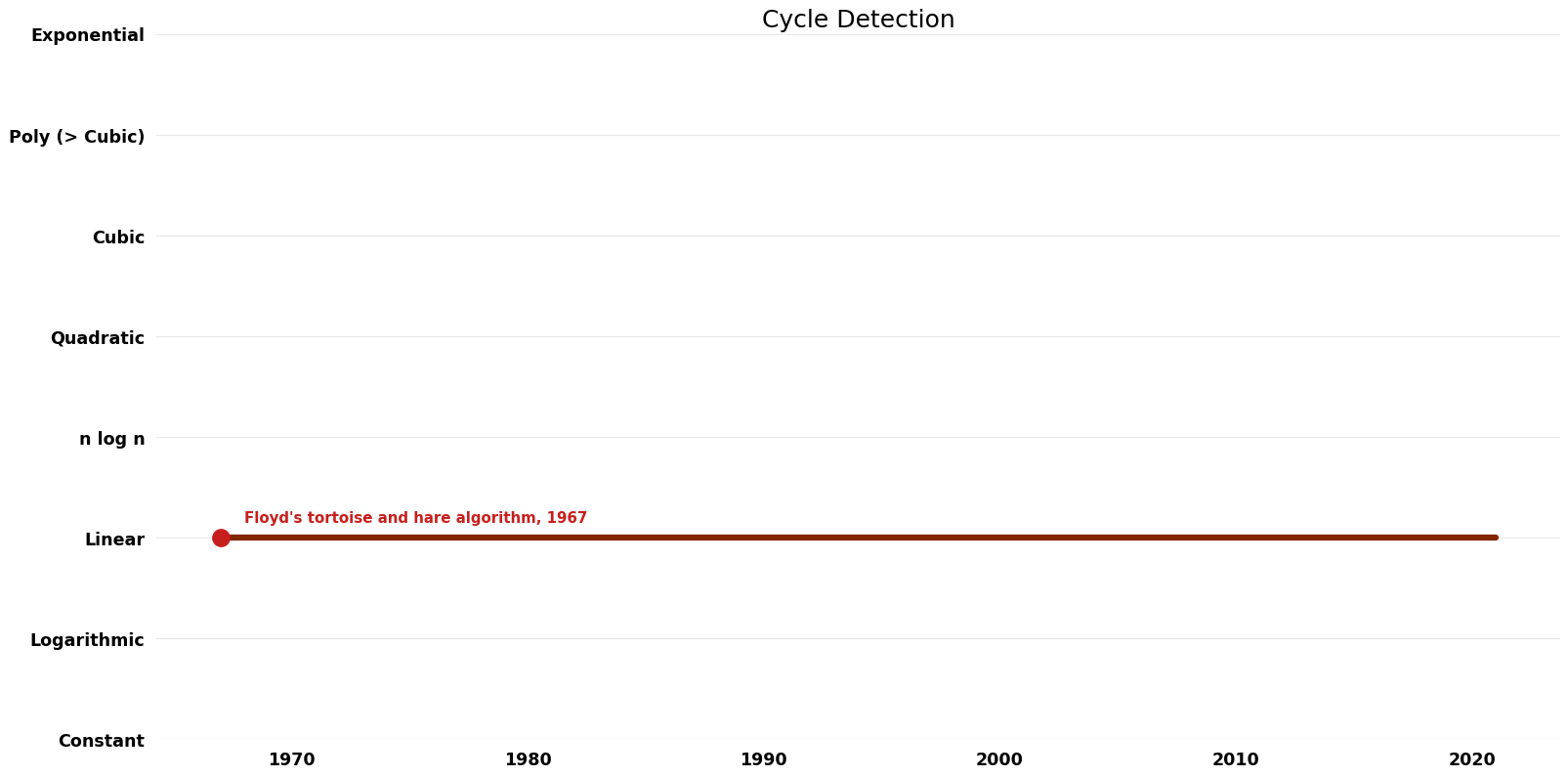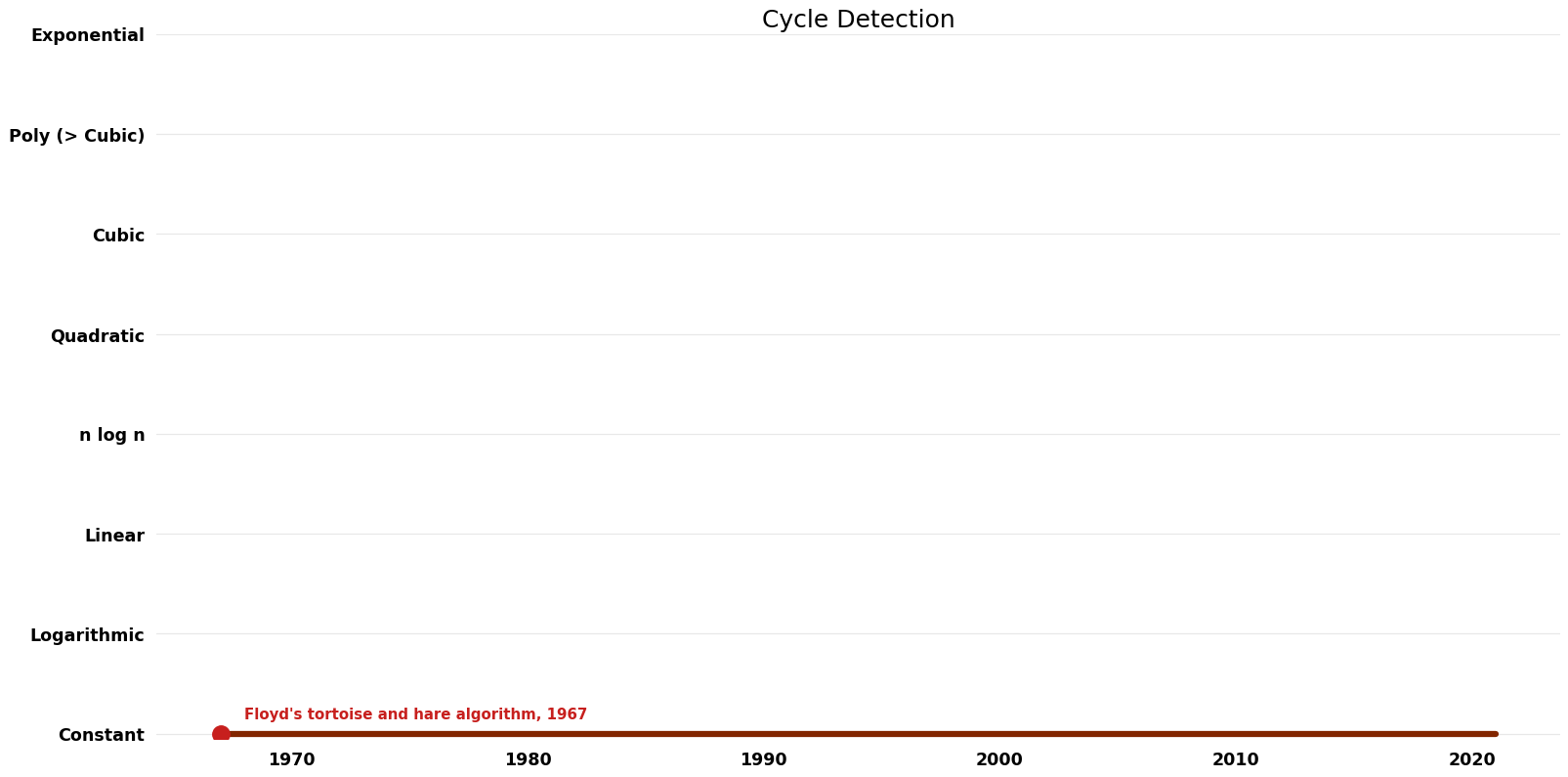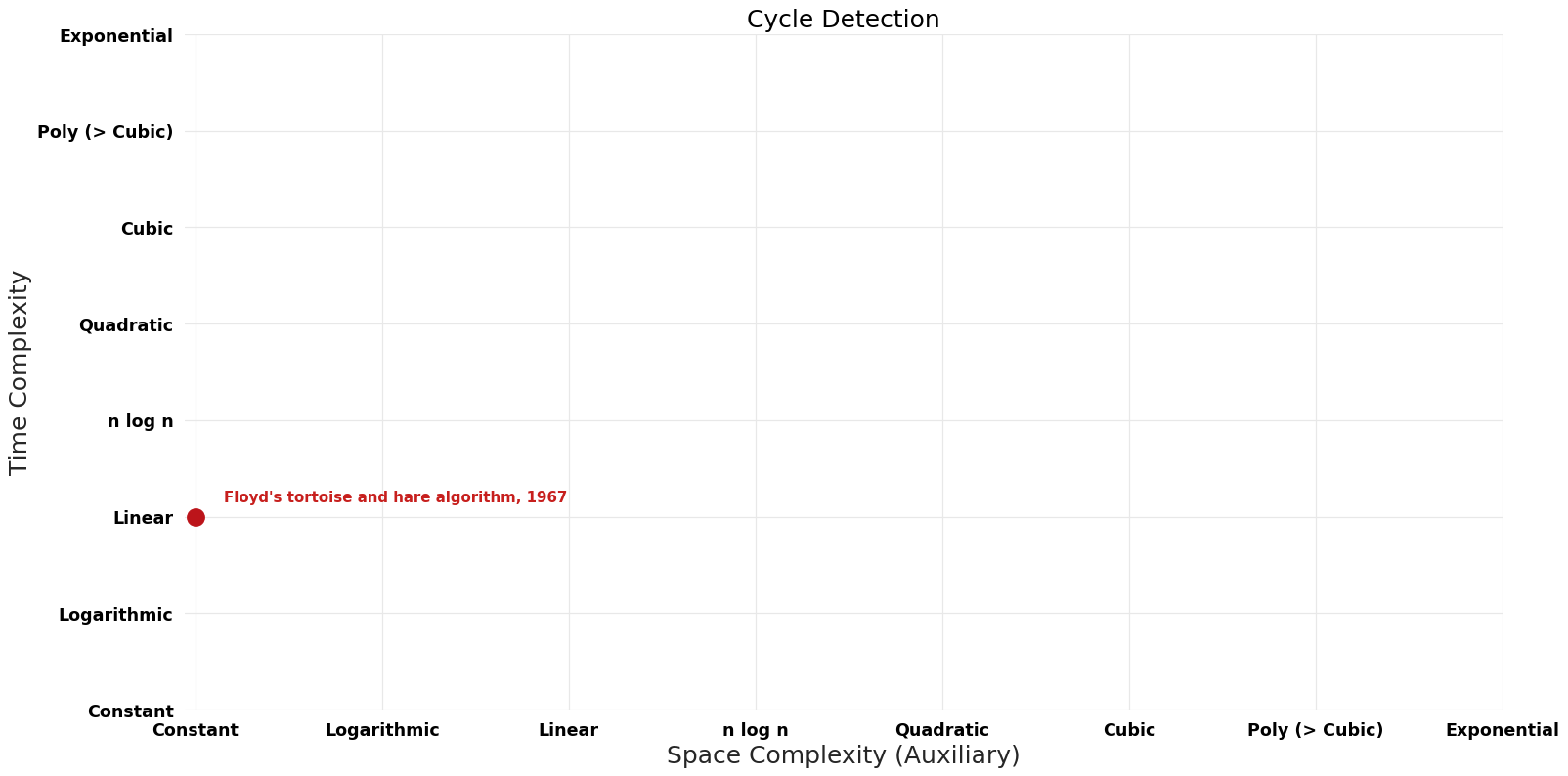Cycle Detection: Difference between revisions
Jump to navigation
Jump to search
(Created page with "== Problem Description== cycle detection or cycle finding is the algorithmic problem of finding a cycle in a sequence of iterated function values. == Bounds Chart == 350px == Step Chart == 350px == Improvement Table == {| class="wikitable" style="text-align:center;" width="100%" !width="20%" | Complexity Classes !! width="40%" | Algorithm Paper Links !! width="40%" | Lower Bounds Paper Li...") |
No edit summary |
||
| Line 1: | Line 1: | ||
== | {{DISPLAYTITLE:Cycle Detection (Cycle Detection)}} | ||
== Description == | |||
Cycle detection or cycle finding is the algorithmic problem of finding a cycle in a sequence of iterated function values. | |||
== | == Parameters == | ||
<pre>t_f: time to perform one evaluation of f | |||
\mu: the starting index of the cycle | |||
\lambda: the period of the cycle | |||
M: number of values stored</pre> | |||
== Table of Algorithms == | |||
{| class="wikitable sortable" style="text-align:center;" width="100%" | |||
! Name !! Year !! Time !! Space !! Approximation Factor !! Model !! Reference | |||
|- | |- | ||
| | |||
| | | [[Sedgewick; Szymanski; and Yao ( Cycle Detection)|Sedgewick; Szymanski; and Yao]] || 1982 || $(\mu + \lambda)({1}+\Theta({1}/sqrt(M)))$ || M || Exact || Deterministic || [https://epubs.siam.org/doi/abs/10.1137/0211030?journalCode=smjcat Time & Space] | ||
| | |||
|- | |- | ||
| | | [[Nivasch ( Cycle Detection)|Nivasch]] || 2004 || $O(\mu + \lambda)$ || $O(logn)$ || Exact || Deterministic || [https://drive.google.com/file/d/16H_lrjeaBJqWvcn07C_w-6VNHldJ-ZZl/view Time] & [https://www.gabrielnivasch.org/fun/cycle-detection Space] | ||
| | |||
| | |||
|- | |- | ||
| | | [[Floyd's tortoise and hare algorithm ( Cycle Detection)|Floyd's tortoise and hare algorithm]] || 1967 || $O((\lambda + \mu)$ t_f) || $O({1})$ || Exact || Deterministic || [http://pds7.egloos.com/pds/200801/07/29/p636-floyd.pdf Time] | ||
| | |||
| | |||
|- | |- | ||
| | | [[Brent's algorithm ( Cycle Detection)|Brent's algorithm]] || 1973 || $O((\lambda + \mu)$ t_f) || $O({1})$ || Exact || Deterministic || [https://maths-people.anu.edu.au/~brent/pd/rpb005.pdf Time] | ||
| | |||
| | |||
|- | |- | ||
| | | [[Gosper's algorithm ( Cycle Detection)|Gosper's algorithm]] || 1978 || $O((\lambda + \mu)$ log(\lambda + \mu) t_f) || \Theta(log(\mu + \lambda)) || Exact || Deterministic || [https://www.inwap.com/pdp10/hbaker/hakmem/flows.html#item132 Time] & [https://en.wikipedia.org/wiki/Cycle_detection#Gosper's_algorithm Space] | ||
| | |||
| | |||
|- | |- | ||
| | |} | ||
| | |||
== Time Complexity graph == | |||
[[File:Cycle Detection - Time.png|1000px]] | |||
== Space Complexity graph == | |||
[[File:Cycle Detection - Space.png|1000px]] | |||
== Pareto Decades graph == | |||
[[File:Cycle Detection - Pareto Frontier.png|1000px]] | |||
== References/Citation == | |||
https://www.sciencedirect.com/science/article/pii/0304397585900441?via%3Dihub | |||
Revision as of 11:20, 15 February 2023
Description
Cycle detection or cycle finding is the algorithmic problem of finding a cycle in a sequence of iterated function values.
Parameters
t_f: time to perform one evaluation of f \mu: the starting index of the cycle \lambda: the period of the cycle M: number of values stored
Table of Algorithms
| Name | Year | Time | Space | Approximation Factor | Model | Reference |
|---|---|---|---|---|---|---|
| Sedgewick; Szymanski; and Yao | 1982 | $(\mu + \lambda)({1}+\Theta({1}/sqrt(M)))$ | M | Exact | Deterministic | Time & Space |
| Nivasch | 2004 | $O(\mu + \lambda)$ | $O(logn)$ | Exact | Deterministic | Time & Space |
| Floyd's tortoise and hare algorithm | 1967 | $O((\lambda + \mu)$ t_f) | $O({1})$ | Exact | Deterministic | Time |
| Brent's algorithm | 1973 | $O((\lambda + \mu)$ t_f) | $O({1})$ | Exact | Deterministic | Time |
| Gosper's algorithm | 1978 | $O((\lambda + \mu)$ log(\lambda + \mu) t_f) | \Theta(log(\mu + \lambda)) | Exact | Deterministic | Time & Space |
Time Complexity graph
Space Complexity graph
Pareto Decades graph
References/Citation
https://www.sciencedirect.com/science/article/pii/0304397585900441?via%3Dihub


